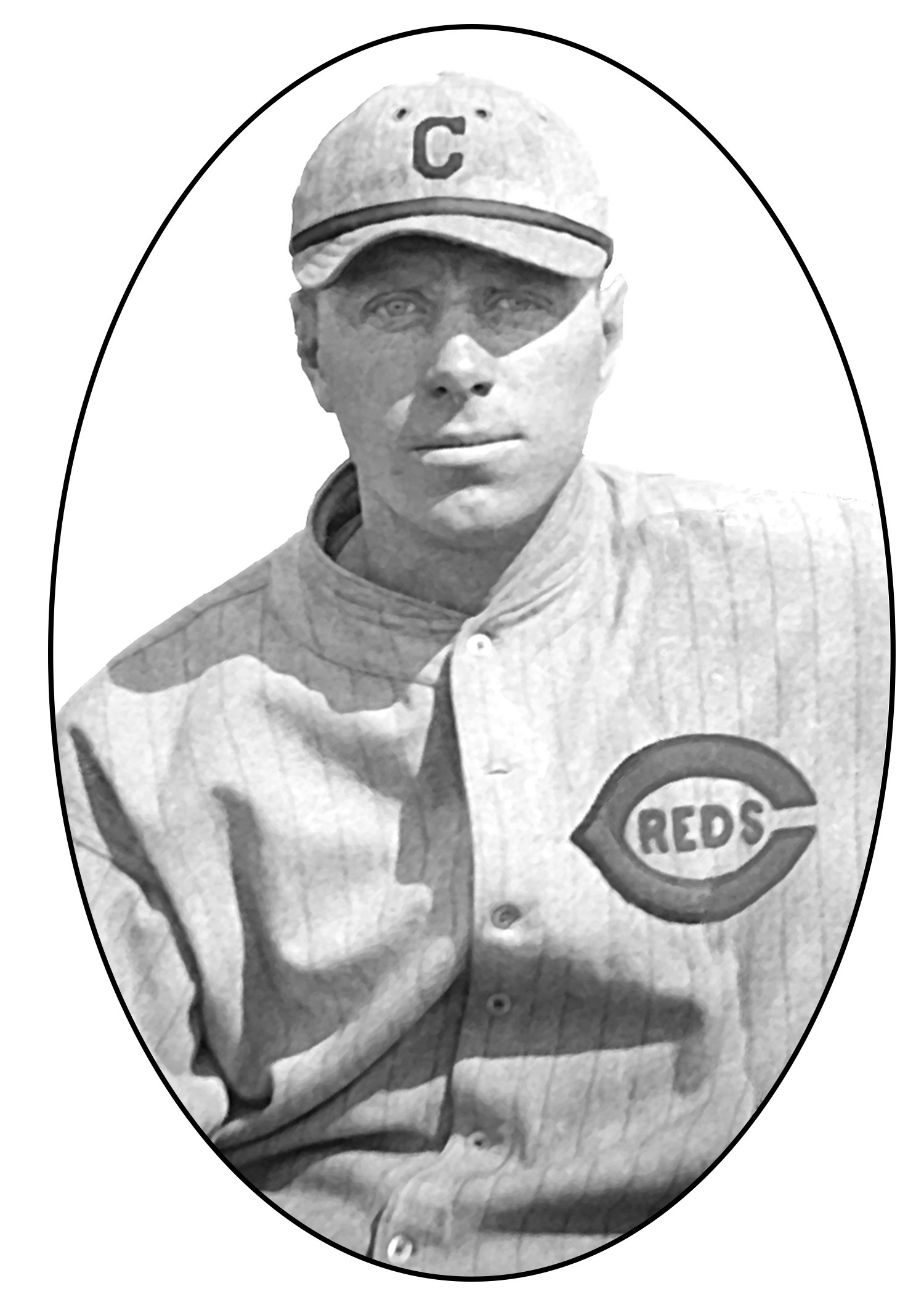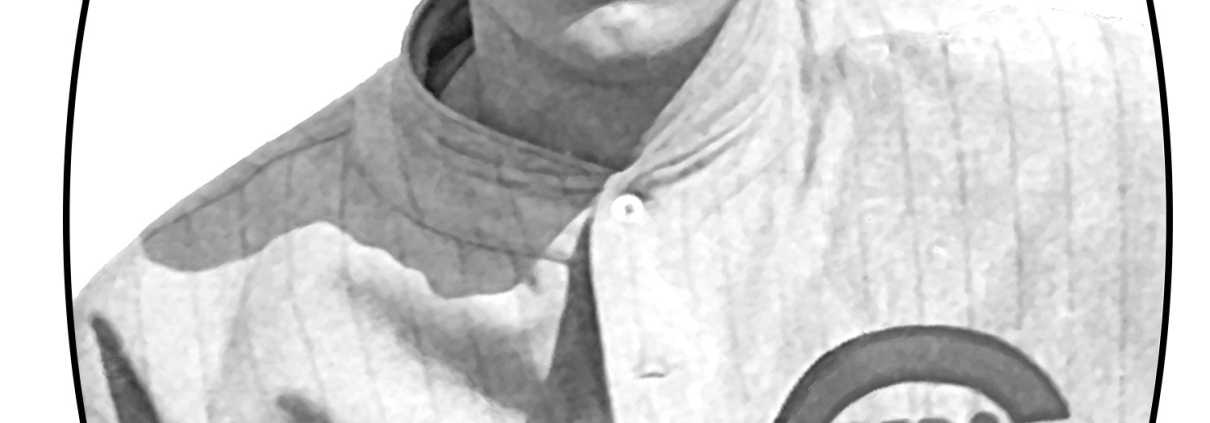Red Lutz
 During the 1922 season, Cincinnati Reds second baseman Lew Fonseca raced back to catch a pop fly in short right field. The right fielder also raced in and the two collided, knocking each other dizzy. Seeing the ball lying on the field with the runners circling the bases was too much for Red Lutz, the Reds’ bullpen catcher, to take. He raced in from the bullpen, picked up the ball, and threw a perfect strike to nail a runner at third. After the dust settled, the baserunner was awarded home by the umpire and the red-faced Lutz returned to the bullpen.1
During the 1922 season, Cincinnati Reds second baseman Lew Fonseca raced back to catch a pop fly in short right field. The right fielder also raced in and the two collided, knocking each other dizzy. Seeing the ball lying on the field with the runners circling the bases was too much for Red Lutz, the Reds’ bullpen catcher, to take. He raced in from the bullpen, picked up the ball, and threw a perfect strike to nail a runner at third. After the dust settled, the baserunner was awarded home by the umpire and the red-faced Lutz returned to the bullpen.1
Louis W. “Red” Lutz was born on December 17, 1898, in Cincinnati to Wilhelm and Rosa (Geiger) Lutz. Rosa Geiger was born in 1862 in Schomberg, Kingdom of Wurttemberg, German Empire. She migrated from Bremen, Germany, to New York City in 1884 and lived in Cincinnati from 1888 until her death in 1935. The housemaid and laundress married Herman Wilhelm Sontag in 1888. They had three children; Freda, Herman Aloysius, and Rose Sontag Thieman. Herman died in 1894. Rosa then married Wilhelm Lutz in Cincinnati on December 30, 1897, and about a year later their son, Louis, was born. Wilhelm, a cabinetmaker, had also migrated from Bremen to New York City, in 1872. Rosa and Wilhelm were married for only a little over four years when Wilhelm died.2
Louis moved with his widowed mother and step-siblings to the Mount Adams neighborhood of Cincinnati in 1904 and he lived there until he entered the Navy. He was baptized in the Church of the Immaculate Conception on February 2, 1899. Beginning in 1903, Louis attended grade school and high school at the church’s Immaculata School in Mount Adams. He played baseball, basketball, and football during his younger years for Immaculata, the Fraternal Order of Elks, and other local teams.3
Father John Philip Maerder was appointed pastor of the church in 1914 and revitalized the Immaculata Athletic Club, which enjoyed great prominence on baseball fields and basketball courts around Cincinnati.4 The pastor and the Immaculata Athletic Club had quite an influence on Lutz’s teenage years and developing his baseball skills.5
Lutz also developed his baseball skills at the Fenwick Club, a young men’s residence and club similar to the YMCA, but with a Catholic approach. The Fenwick Club also had an impact on the youngster’s teenage years, but to a lesser extent than the Immaculata. Lutz played baseball and basketball there as a teenager and returned to play handball at the Fenwick Club after he retired from baseball.6
Lutz enlisted in the US Navy in May 1918 during World War I. He was stationed at the Naval Air Station in Miami, Florida, and was discharged on January 28, 1919.7
Lutz broke into Organized Baseball in 1920, playing for three Class-D Florida State League teams; the Orlando Caps, the St. Petersburg Saints, and the Sanford Celeryfeds. He started the season in Orlando, spent a short time with the Celeryfeds in May because they were out of catchers,8 and then returned to the Caps. In June he was sold to the St. Petersburg Saints, but apparently did not report right away; it was reported that he was sold to the team from Orlando but was fined $25 and suspended for not reporting to the St. Petersburg team.9
In 1921 Lutz played for a semipro Southern Indiana Baseball Association League team in Greensburg, Indiana, and was in the Cincinnati Reds training camp in 1922.10 The Reds already had two catchers who were assured of making the roster, Ivey Wingo and Bubbles Hargrave. The 31-year-old Wingo began his career with the St. Louis Cardinals in 1911 and had been with the Reds since the 1915 season. He hit .260 in his 17-year career with the Cardinals and Reds while throwing out 46 percent of potential basestealers. Wingo was the subject of the bidding war between the Federal League and the American and National Leagues, and his salary with Cincinnati was $6,500 in 1915, a $2,000 raise over the 1914 season. When the Federal League folded after the 1915 season, the Reds attempted to trade Wingo and his large contract. But Reds fans signed a petition to keep Wingo in Cincinnati and the owners obliged. With that popularity, the Reds kept him around through the 1926 season.11
Wingo had not mastered left-handed pitching, so the Reds picked up the good-hitting Bubbles Hargrave to platoon with Wingo for the 1921 season. Hargrave played for Cincinnati for the next eight seasons, hitting over .300 in six consecutive seasons.12
With competition like that, Lutz did not have much of a chance to land a catching job with the Reds. He was, however, able to make the team and spent most of the 1922 season warming up relief pitchers. On May 31 the Pirates led the Reds 11-1 going into the eighth inning. Lutz came in to catch and made a plate appearance. He took advantage of the opportunity by hitting a double.13 Then it was back to the bullpen until Wingo or Hargrave sustained a significant injury, but that didn’t happen for the remainder of the season. He was being paid $450 a month.
Lutz was released by the Reds on May 2, 1923, and returned to minor-league baseball.14 He joined the Oklahoma City Indians of the Class-A Western League and batted .235 in 72 games, splitting time as catcher with Jack Roche and Jimmie Long, who had both seen playing time in the major leagues. “I got more money in the minors,” he said.15
In 1924 Lutz played for the Shenandoah Braves of the independent Anthracite League in Eastern Pennsylvania.
Lutz played for three teams in 1925, the Bridgeport Bears and Worcester Panthers of the Class-A Eastern League and the Shamokin Shammies of the Class-B New York-Penn League, where he hit .320 in 100 at-bats. He played the full year in Shamokin in 1926, batting.256 in 96 games.
Lutz kept his minor-league career going for a few more years. In 1927 he played 25 games for the Haverhill Hillies of the Class-B New England League and 126 games for the Burlington Bees of the Class-D Mississippi Valley League in 1929, where he hit .290 with 130 hits in 449 at-bats. He followed those two impressive seasons by hitting .256 in 73 games with the Fairmont Black Diamonds of the Class-C Middle Atlantic League in 1930. His baseball career appeared to be over after the 1931 season when he played for the Dubuque Tigers and the Moline Plowboys, both of the Class-D Mississippi Valley League.
Lutz stayed in touch with Hargrave and was liked well enough by the Reds organization to be asked to return in 1938 as the player-manager if the Union City Greyhounds of the Kentucky-Illinois-Tennessee (Kitty) League. As a player, the 39-year-old appeared in 15 games in addition to managing the team.
He finished his major-league career having gone 1-for-1 with a double, for a batting average of 1.000, an on-base percentage of 1.000, slugging percentage of 2.000, and an OPS of 3.000.
Except for his time in Union City, Lutz played for some local teams in Cincinnati including Heidelberg Brewing and Coca-Cola between 1936 and 1940.16
In 1923 Lutz had begun working for the New York Central Railroad as a baggage handler, and throughout the years he also worked as a brakeman and conductor on the James Whitcomb Riley passenger train, which operated between Chicago and Cincinnati via Indianapolis. During his baseball career he worked at the railroad during the offseason and during periods of being laid off from the railroad, he did odd jobs like selling coffee and candy door to door. In his early years with the New York Central, he played for the railroad’s basketball team.17
Lutz stayed with the New York Central until August 10, 1968. When the train pulled into Union Terminal in Cincinnati at 11:15 that night, Lutz decided to call it a day after 44 years with the railroad.
On February 25, 1922, before reporting to the Reds training camp, Lutz had married Louise Gillming in Greensburg, Indiana. They had two children, Robert L. Lutz and Ruth Ellen (Lutz) Eggemeier, and eight grandchildren.18
After their marriage, Red and Louise moved to a home in Newport, Kentucky, across the Ohio River from Cincinnati. In 1950 they moved to Cincinnati. Louise died in 1964 and Red lived in their house until 1970, when he had a stroke and moved in with his daughter’s family in Newport.19
After his baseball career, Lutz liked to go to the racetrack once in a while and fished occasionally. He enjoyed traveling with his wife and, after she died, with his daughter’s family. He enjoyed trips to Florida and on a couple of occasions attended Reds spring-training games at Al Lopez Field in Tampa. He loved his dogs and cats and taking long walks. He also enjoyed going to Cincinnati Reds games and was very active until his stoke in 1970.20
Besides his stroke in 1970, Lutz had a heart attack in the early ’50s. Because of circulation problems resulting from the stroke, Red had his left leg amputated in 1980.21
Red Lutz died at the Veterans Hospital in Cincinnati on February 22, 1984, of congestive heart failure. He is buried in St. Stephen Cemetery in Fort Thomas, Kentucky.22
Sources
The author used Retrosheet.org and Baseball-Reference.com for stats and game information, as well as a telephone interview and multiple emails with Bill Eggemeier, a grandson of Red Lutz.
Notes
1 Joe Heffron and Jack Heffron, The Local Boys: Hometown Players for the Cincinnati Reds (Birmingham, Alabama: Clerisy Press, 2014), 123.
2 Bill Eggemeier (grandson), telephone and email correspondence in January/February 2020.
3 Eggemeier.
4 Jim Steiner, “The History of Immaculata School,” Retrieved from: 2011.hciparish.org/wp-content/uploads/2011/02/History-of-Immaculata-School.pdf.
5 Eggemeier.
6 Eggemeier.
7 Eggemeier.
8 Larry, “Sports Chatter by ‘Larry,’” Orlando Sentinel, May 6, 1920: 10.
9 “Florida State League; Dope for the Fans,” Orlando Sentinel, June 25, 1920: 4.
10 Henry Farrell, “Many Rookies in Training Camps,” Daily Republican (Rushville, Indiana), March 16, 1922: 6.
11 Jim Sandoval, “Ivy Wingo,” SABR BioProject, sabr.org/bioproj/person/bac1fa27.
12 Greg Erion, “Bubbles Hargrave,” SABR BioProject, sabr.org/bioproj/person/bac1fa27.
13 “Brief Sports,” Dayton Daily News, June 1, 1922: 8.
14 Eggemeier.
15 Stephen Karan, “Lutz Up … Powie, a Double,” Cincinnati Enquirer, August 13, 1968: 6.
16 Eggemeier
17 Eggemeier.
18 Eggemeier
[19] Eggemeier.
[20] Eggemeier.
[21] Eggemeier.
[22] Eggemeier.
Full Name
Louis William Lutz
Born
December 17, 1898 at Cincinnati, OH (USA)
Died
February 22, 1984 at Cincinnati, OH (USA)
If you can help us improve this player’s biography, contact us.


